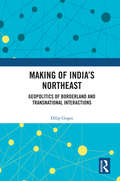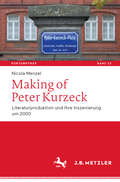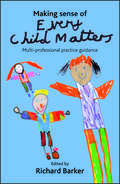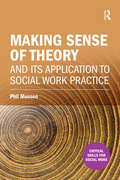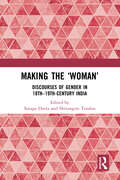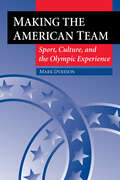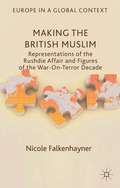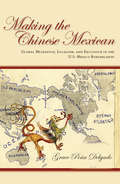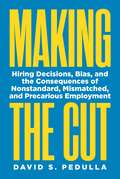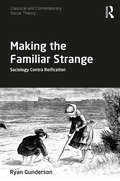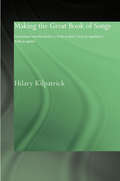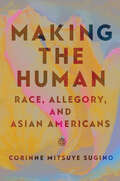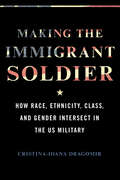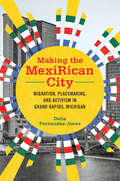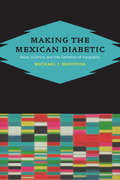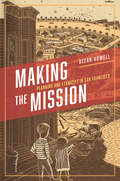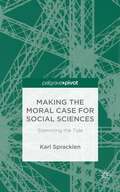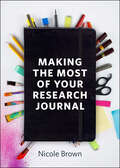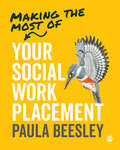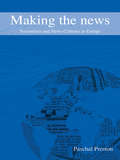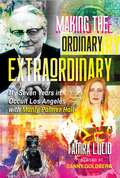- Table View
- List View
Making of India's Northeast: Geopolitics of Borderland and Transnational Interactions
by Dilip GogoiThis book examines India’s Northeast borderland – strategically positioned at the confluence of South Asia, East and Southeast Asia – from the perspective of international relations. The volume interrogates the geopolitics of region-making in both colonial and postcolonial times and traces the transformation of Northeast India from a British strategic frontier into a securitised borderland. It situates the region in transnational interactions both in conflict and cooperation with its immediate neighbouring regions of China, Bangladesh, and Myanmar, especially in the context of India’s Look East/Act East policy. The volume paves the way for a new ‘region-state’ framework borne out of the constructivist worldview and offers answers to many conundrums centring border studies. It further delineates approaches to overcoming the present geopolitical and territorial challenges of India’s Northeast with a critical thrust on regional policymaking. The volume will be of interest to students and researchers in the disciplines of social sciences and humanities in India as well as South and Southeast Asia. It will be especially useful to those in politics and international relations, strategic studies, international political economy, foreign policy, development studies and regional development, besides foreign policy-makers and diplomats, development practitioners, economists and policy analysts.
Making of Peter Kurzeck: Literaturproduktion und ihre Inszenierung um 2000 (Kontemporär. Schriften zur deutschsprachigen Gegenwartsliteratur #22)
by Nicola MenzelDie Studie untersucht die öffentliche Darstellung des Schreibprozesses Peter Kurzecks. Seine mehrbändige autofiktionale Romanreihe Das alte Jahrhundert sowie seine frei eingesprochenen Hörbücher wurden im Feuilleton einhellig als außergewöhnlich besprochen. Sie gelten als authentische Rarität in einem sich ansonsten zunehmend popularisierendem Literaturbetrieb. Die Arbeit zeigt hingegen, dass das Phänomen Kurzeck keinesfalls abseits eines ökonomisierten und medialisierten gegenwartskulturellen Feldes steht. Vielmehr lassen sich typische populäre und ökonomische Mechanismen ablesen wie u.a. Mehrfachadressierung, Zweitverwertung, Serialität und Fankultur. Auch das Phänomen Kurzeck selbst wirkt auf das Feld ein, von dem es sich abzusondern scheint, und zwar nicht trotz des autonomieästhetischen Gestus, sondern gerade deswegen. Kurzeck wird mithin als gegenwartsästhetisches Phänomen untersucht, bei dem Marktdistinktion zum Verkaufsargument wird.Exemplarisch an Kurzeck wird gezeigt, dass sich Formationen des gegenwartskulturellen Feldes um 2000 auch dort ablesen lassen, wo sie nicht erwartet werden. Die Arbeit regt dazu an, einen emphatischen Literaturbegriff als grundsätzlich produzierbar und konsumierbar zu verstehen, mit Blick auf Kurzeck als werkpolitischer Effekt der Selbst- und Schreibdarstellung einer Autorfigur. Als Beitrag zur Gegenwartsliteraturforschung regt sie darüber hinaus zur Reflexion der literaturwissenschaftlichen Haltung gegenüber ihrem Gegenstand und den eigenen Forschungspraktiken an.Methodisch verbindet sie feldtheoretische Fragen mit close readings nicht nur literarischer Texte und ihrer Vorarbeiten aus dem Nachlass Kurzecks, sondern auch von Interviews, Preisreden, Videoaufnahmen von Lesungen, einem öffentlichen Manuskriptdiktat im Frankfurter Literaturhaus sowie der Peter-Kurzeck-App. Das dafür entwickelte umfassende methodische Modell stellt einen generellen Vorschlag dar zur Analyse gegenwartsliterarischer Gegenstände, bei der literaturwissenschaftliche Methoden mit ökonomischen, paratextuellen, soziologischen, praxeologischen und kulturästhetischen Aspekten im Dialog stehen.
Making sense of Every Child Matters: Multi-professional practice guidance
by Richard BarkerThis much-needed book examines the implications of the 'Every Child Matters' (ECM) national and local framework for working with children. It analyses the key issues from the perspective of the different professions that make up the 'new children's workforce' and explores interprofessional considerations. The book includes practice issues and case examples from health, education, social work, playwork, children's centres and early years, and considers the opportunities and challenges presented by the current agenda. It will be widely welcomed by tutors and practitioners alike, enabling readers to make sense of the legislation and national guidance, and to understand better the new agendas for children's services. For more information visit: http://www.everychildmattersbook.co.uk/
Making sense of theory and its application to social work practice
by Phil MussonDo you struggle to get your head around the application of theory and associated methods of intervention to social work practice? Making sense of theory and its application to social work practice is here to help you with a fresh approach written with the ‘non- theoretician’ in mind. After exploring the expectations and limits of application of theory to practice, Phil Musson sets about describing theories of explanation and their associated methods of intervention in an accessible way. He follows this by looking at theoretically driven approaches and their associated methods of intervention. One generic case study is used throughout, tweaked slightly but maintaining the same service users and issues so you can see how the theory of explanation or approach and the associated method of intervention is applied. You are also able to sharpen up your critical thinking skills as the author invites you to reflect on the theories of explanation and approaches discussed.Making Sense of Theory and its Application to Social Work Practice will be immensely valuable to both social work students and practitioners.
Making the 'Woman': Discourses of Gender in 18th-19th century India
by Sutapa Dutta Shivangini TandonThe book examines the representation of women, their agency and subjectivity and gender relations in 18th- and 19th-century India. The chapters in the volume interrogate notions and discourses of ‘women’ and ‘gender’ during the period, historically shaped by multiple and even competing actors, practices and institutions. They highlight the ‘making of the woman’ across a wide spectrum of subject areas, regions and roles and attempt to understand the contradictions and differences in social experiences and identity formations of women. The volume also deals with prevalent notions of masculinity and femininity, normative and non-conformist expressions of gender and sexual identity and epistemological concerns of gender, especially in its intersectional interplay with other axes of caste, class, race, region and empire. Presenting unique understandings of our gendered pasts, this volume will be of great interest to scholars and researchers of history, gender studies and South Asian studies.
Making the American Team: Sport, Culture, and the Olympic Experience (Sport and Society)
by Mark DyresonSport dominates television and the mass media. Politics and business are a-bustle with sports metaphors. Endorsements by athletes sell us products. "Home run," "slam dunk," and the rest of the vocabulary of sport color daily conversation. Even in times of crisis and emergency, the media reports the scores and highlights. Marky Dyreson delves into how our obsession with sport came into being with a close look at coverage of the Olympic Games between 1896 and 1912. How people reported and consumed information on the Olympics offers insight into how sport entered the heart of American culture as part of an impetus for social reform. Political leaders came to believe in the power of sport to revitalize the "republican experiment." Sport could instill a new sense of national identity that would forge a new sense of community and a healthy political order while at the same time linking America's intellectual and power elite with the experiences of the masses.
Making the British Muslim
by Nicole FalkenhaynerTracing representations of the Rushdie affair from 1989 to 2009, this study establishes a genealogy of how British Muslims appeared on the public scene and how an imaginary and politics of this subject position developed.
Making the Carry: The Lives of John and Tchi-Ki-Wis Linklater
by Timothy CochraneAn extraordinary illustrated biography of a Métis man and Anishinaabe woman navigating great changes in their homeland along the U.S.–Canada border in the early twentieth century John Linklater, of Anishinaabeg, Cree, and Scottish ancestry, and his wife, Tchi-Ki-Wis, of the Lac La Croix First Nation, lived in the canoe and border country of Ontario and Minnesota from the 1870s until the 1930s. During that time, the couple experienced radical upheavals in the Quetico–Superior region, including the cutting of white and red pine forests, the creation of Indian reserves/reservations and conservation areas, and the rise of towns, tourism, and mining. With broad geographical sweep, historical significance, and biographical depth, Making the Carry tells their story, overlooked for far too long.John Linklater, a renowned game warden and skilled woodsman, was also the bearer of traditional ecological knowledge and Indigenous heritage, both of which he was deeply committed to teaching others. He was sought by professors, newspaper reporters, museum personnel, and conservationists—among them Sigurd Olson, who considered Linklater a mentor. Tchi-Ki-Wis, an extraordinary craftswoman, made a sweeping array of necessary yet beautiful objects, from sled dog harnesses to moose calls to birch bark canoes. She was an expert weaver of large Anishinaabeg cedar bark mats with complicated geometric designs, a virtually lost art.Making the Carry traces the routes by which the couple came to live on Basswood Lake on the international border. John&’s Métis ancestors with deep Hudson&’s Bay Company roots originally came from Orkney Islands, Scotland, by way of Hudson Bay and Red River, or what is now Winnipeg. His family lived in Manitoba, northwest Ontario, northern Minnesota, and, in the case ofJohn and Tchi-Ki-Wis, on Isle Royale. A journey through little-known Canadian history, the book provides an intimate portrait of Métis people.Complete with rarely seen photographs of activities from dog mushing to guiding to lumbering, as well as of many objects made by Tchi-Ki-Wis, such as canoes, moccasins, and cedar mats, Making the Carry is a window on a traditional way of life and a restoration of two fascinating Indigenous people to their rightful place in our collective past.
Making the Chinese Mexican: Global Migration, Localism, and Exclusion in the U.S.-Mexico Borderlands
by Grace Peña DelgadoMaking the Chinese Mexicanis the first book to examine the Chinese diaspora in the U. S. -Mexico borderlands. It presents a fresh perspective on immigration, nationalism, and racism through the experiences of Chinese migrants in the region during the late nineteenth and early twentieth centuries. Navigating the interlocking global and local systems of migration that underlay Chinese borderlands communities, the author situates the often-paradoxical existence of these communities within the turbulence of exclusionary nationalisms. The world of Chinesefronterizos(borderlanders) was shaped by the convergence of trans-Pacific networks and local arrangements: against a backdrop of national unrest in Mexico and in the era of exclusionary immigration policies in the United States, Chinesefronterizoscarved out vibrant, enduring communities that provided a buffer against virulent Sinophobia. This book challenges us to reexamine the complexities of nation-making, identity formation, and the meaning of citizenship. It represents an essential contribution to our understanding of the U. S. -Mexico borderlands.
Making the Cut: Hiring Decisions, Bias, and the Consequences of Nonstandard, Mismatched, and Precarious Employment
by David PedullaAn in-depth look at how employers today perceive and evaluate job applicants with nonstandard or precarious employment historiesMillions of workers today labor in nontraditional situations involving part-time work, temporary agency employment, and skills underutilization or face the precariousness of long-term unemployment. To date, research has largely focused on how these experiences shape workers’ well-being, rather than how hiring agents perceive and treat job applicants who have moved through these positions. Shifting the focus from workers to hiring agents, Making the Cut explores how key gatekeepers—HR managers, recruiters, and talent acquisition specialists—evaluate workers with nonstandard, mismatched, or precarious employment experience. Factoring in the social groups to which workers belong—such as their race and gender—David Pedulla shows how workers get jobs, how the hiring process unfolds, who makes the cut, and who does not.Drawing on a field experiment examining hiring decisions in four occupational groups and in-depth interviews with hiring agents in the United States, Pedulla documents and unpacks three important discoveries. Hiring professionals extract distinct meanings from different types of employment experiences; the effects of nonstandard, mismatched, and precarious employment histories for workers’ job outcomes are not all the same; and the race and gender of workers intersect with their employment histories to shape which workers get called back for jobs. Indeed, hiring professionals use group-based stereotypes to weave divergent narratives or “stratified stories” about workers with similar employment experiences. The result is a complex set of inequalities in the labor market.Looking at bias and discrimination, social exclusion in the workplace, and the changing nature of work, Making the Cut probes the hiring process and offers a clearer picture of the underpinnings of getting a job in the new economy.
Making the Familiar Strange: Sociology Contra Reification (Classical and Contemporary Social Theory)
by Ryan GundersonThis book examines the meaning and implications of the sociological maxim, ‘make the familiar strange’. Addressing the methodological questions of why and how sociologists should make the familiar strange, what it means to ‘make the familiar strange’, and how this approach benefits sociological research and theory, it draws on four central concepts: reification, familiarity, strangeness, and defamiliarization. Through a typology of the notoriously ambiguous concept of reification, the author argues that the primary barrier to sociological knowledge is our experience of the social world as fixed and unchangeable. Thus emerges the importance of constituting the familiar as the strange through a process of social defamiliarization as well as making this process more methodical by reflecting on heuristics and patterns of thinking that render society strange. The first concerted effort to examine an important feature of the sociological imagination, this volume will appeal to sociologists of any specialty and theoretical persuasion.
Making the Great Book of Songs: Compilation and the Author's Craft in Abû I-Faraj al-Isbahânî's Kitâb al-aghânî (Routledge Studies in Middle Eastern Literatures)
by Hilary KilpatrickThis is the first systematic literary study of one of the masterpieces of classical Arabic literature, the fourth/tenth century Kitâb al-aghânî (The Book of Songs) by Abû I-Faraj al-Isbahânî. Until now the twenty-four volume Book of Songs has been regarded as a rather chaotic but priceless mine of information about classical Arabic music, literature and culture. This book approaches it as a work of literature in its own right, with its own internal logic and coherence. The study also consistently integrates the musical component into the analysis and proposes a reading of the work in which individual anecdotes and poems are related to the wider context, enhancing their meaning.
Making the Human: Race, Allegory, and Asian Americans (Asian American Studies Today)
by Corinne Mitsuye SuginoFrom the debate over affirmative action to the increasingly visible racism amidst the COVID-19 pandemic, Asian Americans have emerged as key figures in a number of contemporary social controversies. In Making the Human: Race, Allegory, and Asian Americans, Corinne Mitsuye Sugino offers the lens of racial allegory to consider how media, institutional, and cultural narratives mobilize difference to normalize a white, Western conception of the human. Rather than focusing on a singular arena of society, Sugino considers contemporary sources across media, law, and popular culture to understand how they interact as dynamic sites of meaning-making. Drawing on scholarship in Asian American studies, Black studies, cultural studies, communication, and gender and sexuality studies, Sugino argues that Asian American racialization and gendering plays a key role in shoring up abstract concepts such as “meritocracy,” “family,” “justice,” “diversity,” and “nation” in ways that naturalize hierarchy. In doing so, Making the Human grapples with anti-Asian racism’s entanglements with colonialism, antiblackness, capitalism, and gendered violence.
Making the Immigrant Soldier: How Race, Ethnicity, Class, and Gender Intersect in the US Military
by Cristina-Ioana DragomirImmigrants to the United States have long used the armed forces as a shortcut to citizenship. Cristina-Ioana Dragomir profiles Lily, Alexa, and Vikrant, three immigrants of varying nationalities and backgrounds who chose military service as their way of becoming American citizens. Privileging the trio’s own words and experiences, Dragomir crafts a human-focused narrative that moves from their lives in their home countries and decisions to join the military to their fraught naturalization processes within the service. Dragomir illuminates how race, ethnicity, class, and gender impacted their transformation from immigrant to soldier, veteran, and American. She explores how these factors both eased their journeys and created obstacles that complicated their access to healthcare, education, economic resources, and other forms of social justice. A compelling union of analysis and rich storytelling, Making the Immigrant Soldier traces the complexities of serving in the military in order to pursue the American dream.
Making the Invisible Visible
by Tojo Thatchenkery Keimei SugiyamaWhen we think of the most visible person in the workplace, we typically think of those who are in the most senior leadership positions; the CEO, the president of the organization. We assume that having visibility means leadership through "showing" others what it means to be a leader. Yet Tojo Thatchenkery and Keimei Sugiyama found different and more collectively focused themes for leadership. "Making the Invisible Visible" isa study of Asians and Asian Americans in the workplace and provides a framework through which to transform the same qualities that are contributing to this invisibility phenomenon into a positive leadership approach that provides a counterweight to balance the showmanship approach to leadership. Showmanship can lead to short term achievement; however, an environment full of only this kind of leadership does not provide the opportunity for long term sustainable performance. They also discuss strategies for Asians and Asian Americans for career management. The invisible leaders that are going unseen today can be the visible leaders of tomorrow. "
Making the MexiRican City: Migration, Placemaking, and Activism in Grand Rapids, Michigan (Latinos in Chicago and Midwest)
by Delia Fernández-JonesLarge numbers of Latino migrants began to arrive in Grand Rapids, Michigan, in the 1950s. They joined a small but established Spanish-speaking community of people from Texas, Mexico, and Puerto Rico. Delia Fernández-Jones merges storytelling with historical analysis to recapture the placemaking practices that these Mexicans, Tejanos, and Puerto Ricans used to create a new home for themselves. Faced with entrenched white racism and hostility, Latinos of different backgrounds formed powerful relationships to better secure material needs like houses and jobs and to recreate community cultural practices. Their pan-Latino solidarity crossed ethnic and racial boundaries and shaped activist efforts that emphasized working within the system to advocate for social change. In time, this interethnic Latino alliance exploited cracks in both overt and structural racism and attracted white and Black partners to fight for equality in social welfare programs, policing, and education. Groundbreaking and revelatory, Making the MexiRican City details how disparate Latino communities came together to respond to social, racial, and economic challenges.
Making the Mexican Diabetic: Race, Science, and the Genetics of Inequality
by Michael MontoyaThis innovative ethnographic study animates the racial politics that underlie genomic research into type 2 diabetes, one of the most widespread chronic diseases and one that affects ethnic groups disproportionately. Michael J. Montoya follows blood donations from "Mexican-American" donors to laboratories that are searching out genetic contributions to diabetes. His analysis lays bare the politics and ethics of the research process, addressing the implicit contradiction of undertaking genetic research that reinscribes race's importance even as it is being demonstrated to have little scientific validity. In placing DNA sampling, processing, data set sharing, and carefully crafted science into a broader social context, Making the Mexican Diabetic underscores the implications of geneticizing disease while illuminating the significance of type 2 diabetes research in American life.
Making the Mission: Planning and Ethnicity in San Francisco
by Ocean HowellIn the aftermath of the 1906 San Francisco earthquake, residents of the city's iconic Mission District bucked the city-wide development plan, defiantly announcing that in their neighborhood, they would be calling the shots. Ever since, the Mission has become known as a city within a city, and a place where residents have, over the last century, organized and reorganized themselves to make the neighborhood in their own image. In Making the Mission, Ocean Howell tells the story of how residents of the Mission District organized to claim the right to plan their own neighborhood and how they mobilized a politics of place and ethnicity to create a strong, often racialized identity--a pattern that would repeat itself again and again throughout the twentieth century. Surveying the perspectives of formal and informal groups, city officials and district residents, local and federal agencies, Howell articulates how these actors worked with and against one another to establish the very ideas of the public and the public interest, as well as to negotiate and renegotiate what the neighborhood wanted. In the process, he shows that national narratives about how cities grow and change are fundamentally insufficient; everything is always shaped by local actors and concerns.
Making the Moral Case for Social Sciences: Stemming the Tide
by Karl SpracklenThe social sciences have a legitimacy problem in the modern world. The natural sciences are viewed as 'proper science' by journalists and policy-makers because they discover 'truths', make money, and help governments solve problems. In turn, defenders of the social sciences borrow the language of instrumentality, profit and policy impact. Karl Spracklen, by contrast, makes the moral case for the social sciences, arguing that they are a necessary social good capable of fighting inequality and revealing the workings of hegemonic power.
Making the Most of Your Research Journal
by Nicole BrownProviding practical guidance based on real-life examples, this book shows researchers different forms and ways of keeping a research journal and how to get the most out of journaling. Appealing to postgraduate students, new and experienced researchers, the book: • provides a theoretical grounding and information about knowledge and sensory systems and reflexivity; • presents a practical exploration of what a journal looks like and when and how to record entries; • includes helpful end-of-chapter exercises and online resources. Providing valuable food for thought and examples to experiment with, the book highlights the different forms of research journals and entries so that readers can find what works for them. Giving researchers licence to do things differently, the book encourages and enables readers to develop their own sense of researcher identity and voice.
Making the Most of Your Social Work Placement
by Paula Beesley'How can I succeed in my placement?' Your placement is a crucial part of your social work training - not only will a successful placement set you up to succeed in the rest of your degree, but it is also your chance to experience what real social work practice is like. This practical guide will takes you step by step through your social work placement, guiding you through what you will be expected to do, and helping you to make the most of your placement. You will learn how to apply the theory and skills you've learnt in practice, to your own observations as well as to your placement portfolio, and how to gain the feedback you need. The books is packed full of hands-on advice, alongside a variety of learning features: student voices talking about their own placement experiences, chapter checklists, reflective tasks, and potential placement pitfalls and opportunities which demonstrate different ways to approach situations you may encounter on placement.
Making the Most of Your Social Work Placement
by Paula BeesleyThis practical guide will takes you step by step through your social work placement, guiding you through what you will be expected to do, and helping you to make the most of your placement. You will learn how to apply the theory and skills you′ve learnt in practice, to your own observations as well as to your placement portfolio, and how to gain the feedback you need. The books is packed full of hands-on advice, alongside a variety of learning features: student voices talking about their own placement experiences, chapter checklists, reflective tasks, and potential placement pitfalls and opportunities which demonstrate different ways to approach situations you may encounter on placement.
Making the News: Journalism and News Cultures in Europe
by Paschal PrestonMaking the News provides a cross-national perspective on key features of journalism and news-making cultures and the changing media landscape in contemporary Europe. . Focusing on the key trends, practices and issues in contemporary journalism and news cultures, Paschal Preston maps the major contours of change as well as the broader industrial, organizational, institutional and cultural factors shaping journalism practices over the past two decades. Moving beyond the tendency to focus on journalism trends and newsmaking practices within a single country, Making the News draws on unique, cross-national research examining current journalism practices and related newsmaking cultures in eleven West, Central and East European countries, including in-depth interviews with almost 100 senior journalists and subsequent workshop discussions with other interest groups Making the News links reviews and discussions of the existing literature to original research engaging with the views and experiences of journalists working at the ‘coal face’ of contemporary newsmaking practices, to provide an original study and useful student text.
Making the Nonprofit Sector in the United States: A Reader
by David C. Hammack"It is a delight to seen an anthology on nonprofit history done so well."—Barry Karl, John F. Kennedy School of Government, Harvard University"This is a volume that everyone concerned about nonprofits—scholar, practitioner, and citizen—will find useful and illuminating."—Peter Dobkin Hall, Program on Non-Profit OrganizationsYale Divinity School"A remarkable book."—Robert Putnam, John F. Kennedy School of Government, Harvard University[One to come from John Simon, School of Law, Yale University by Jan. 13th and others are being solicited.] Unique among nations, America conducts almost all of its formally organized religious activity, and many cultural, arts, human service, educational, and research activities through private nonprofit organizations. Though partially funded by government, as well as by fees and donations, American nonprofits have pursued their missions with considerable independence. Many have amassed remarkable resources and acquired some of the most impressive hospital, university, performing arts, and museum facilities in the world. While some have amassed large endowments, many that surpass one billion dollars, there are also hundreds of thousands of small nonprofits, most with no tangible resources at all. How did the United States come to rely so heavily on nonprofits? Why has it continued to do so? What purposes do Americans seek to advance through nonprofits? How have Americans sought to control them? How have nonprofits been effected by the growth of government in the twentieth century? These questions suggest the complexity of the history of nonprofits in the United States. To help explore that history, this reader presents some of the classic documents in the development of the nonprofit sector along with important interpretations by recent scholars. The selections can be considered a representative part of a single extended conversation by the men and women who have taken part in the effort to define America and the American dream, even as they shaped what we now call the nonprofit sector. The statements by participants in the growth and development of the nonprofit sector are accompanied by essays written by historians and social scientists that provide concise surveys of important issues and periods. The essays give voice to those whose contributions to the American debate about voluntary associations and private institutions would otherwise be difficult to find or comprehend.The selections can be considered a representative part of a single extended conversation by the men and women who have taken part in the effort to define America and the American dream, even as they shaped what we now call the nonprofit sector. The statements by participants in the growth and development of the nonprofit sector are accompanied by essays written by historians and social scientists that provide concise surveys of important issues and periods. The essays give voice to those whose contributions to the American debate about voluntary associations and private institutions would otherwise be difficult to find or comprehend. Each selection has been chosen to define or illuminate important questions in the development of the nonprofit sector in the United States. Many include criticisms of particular nonprofit efforts, or of nonprofit activity in general. The intention is to provoke thought, not to establish an official list of readings. Though not every point of view could be included, the reader does reflect a general understanding of the nature of the nonprofit sector and its significance in the development of the United States. Philanthropic Studies—Dwight F. Burlingame and David C. Hammack, general editors
Making the Ordinary Extraordinary: My Seven Years in Occult Los Angeles with Manly Palmer Hall
by Tamra Lucid• Details how the author and her boyfriend developed a close friendship with Manly Hall and how Hall at first mistook her boyfriend as his heir apparent • Explains how Hall adopted the author as his &“girl Friday&” and personal weirdo screener, giving her access to the inner circles of occult Los Angeles • Richly depicts the characters who worked and gathered at Hall&’s Philosophical Research Society, including Hall&’s wife, the famed &“Mad Marie&” In the early 1980s, underground musicians Tamra Lucid and her boyfriend Ronnie Pontiac discovered the book The Secret Teachings of All Ages at the Bodhi Tree bookstore in Los Angeles. Poring over the tome, they were awakened to the esoteric and occult teachings of the world. Tamra and Ronnie were delighted to discover that the book&’s author, Manly Palmer Hall (1901-1990), master teacher of Hermetic mysteries and collector of all things mystical, lived in LA and gave lectures every Sunday at his mystery school, the Philosophical Research Society (PRS). After their first tantalizing Sunday lecture, Tamra and Ronnie soon started volunteering at the PRS, beginning a seven-year friendship with Manly P. Hall, who eventually officiated their wedding in his backyard. In this touching, hilarious, and ultimately tragic autobiographical account, Tamra shares an intimate portrait of Hall and the occult world of New Age Los Angeles, including encounters with astrologers, scholars, artists, spiritual seekers, and celebrities such as Jean Houston and Marianne Williamson. Tamra vividly describes how she used her time at the PRS to learn everything she could not only about metaphysics but also about the people who practice it. But when Tamra begs Hall to banish a certain man from the PRS--the same man who inherited Hall&’s estate and whom his wife Marie later alleged was Hall&’s murderer--Tamra and Ronnie are the ones banished. Tamra&’s noir chronicle of an improbable friendship between a twenty-something punk and an eighty-year-old metaphysical scholar reveals Hall not only as an inspiring esoteric thinker but also as a genuinely kind human being who simply wanted to share his quest for inner meaning and rare wisdom with the world.
